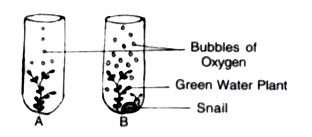Test tube (A) contains aqueous zinc acetate solution while test tube (B) contains aq, zinc chloride solution .What happens if H2S gas is passed into each solution ?
Step-by-Step Solution:
1. Identify the Solutions:
- Test tube (A) contains aqueous zinc acetate (Zn(CH₃COO)₂).
- Test tube (B) contains aqueous zinc chloride (ZnCl₂).
2. Pass H₂S Gas into Test Tube A (Zinc Acetate):
- When H₂S gas is introduced into the zinc acetate solution, a reaction occurs.
- The zinc acetate reacts with hydrogen sulfide to form zinc sulfide (ZnS) and acetic acid (CH₃COOH).
- The balanced chemical reaction is:
Zn(CH3COO)2+H2S→ZnS (s)+2CH3COOH
- Zinc sulfide (ZnS) is a solid precipitate that forms in this reaction.
3. Pass H₂S Gas into Test Tube B (Zinc Chloride):
- When H₂S gas is passed into the zinc chloride solution, a different reaction occurs.
- The zinc chloride reacts with hydrogen sulfide to form zinc sulfide (ZnS) and hydrochloric acid (HCl).
- The balanced chemical reaction is:
ZnCl2+H2S→ZnS (s)+2HCl
- However, in the presence of HCl, zinc sulfide remains soluble, and thus no precipitate is observed.
4. Conclusion:
- In test tube A (zinc acetate), a precipitate of zinc sulfide forms.
- In test tube B (zinc chloride), no precipitate is formed due to the solubility of zinc sulfide in HCl.
- Test tube (A) contains aqueous zinc acetate (Zn(CH₃COO)₂).
- Test tube (B) contains aqueous zinc chloride (ZnCl₂).
- When H₂S gas is introduced into the zinc acetate solution, a reaction occurs.
- The zinc acetate reacts with hydrogen sulfide to form zinc sulfide (ZnS) and acetic acid (CH₃COOH).
- The balanced chemical reaction is:
Zn(CH3COO)2+H2S→ZnS (s)+2CH3COOH
- Zinc sulfide (ZnS) is a solid precipitate that forms in this reaction.
- When H₂S gas is passed into the zinc chloride solution, a different reaction occurs.
- The zinc chloride reacts with hydrogen sulfide to form zinc sulfide (ZnS) and hydrochloric acid (HCl).
- The balanced chemical reaction is:
ZnCl2+H2S→ZnS (s)+2HCl
- However, in the presence of HCl, zinc sulfide remains soluble, and thus no precipitate is observed.
- In test tube A (zinc acetate), a precipitate of zinc sulfide forms.
- In test tube B (zinc chloride), no precipitate is formed due to the solubility of zinc sulfide in HCl.
Topper's Solved these Questions
- QUALITATIVE INORGANIC SALT ANALYSISBOOK - CENGAGE CHEMISTRY ENGLISHCHAPTER - QUALITATIVE INORGANIC SALT ANALYSISEXERCISE - Solved Example
11 Videos
- QUALITATIVE INORGANIC SALT ANALYSISBOOK - CENGAGE CHEMISTRY ENGLISHCHAPTER - QUALITATIVE INORGANIC SALT ANALYSISEXERCISE - Exercises (Linked Comprehension)
67 Videos
- P-BLOCK GROUP 18 ELEMENTS - THE INERT GASESBOOK - CENGAGE CHEMISTRY ENGLISHCHAPTER - P-BLOCK GROUP 18 ELEMENTS - THE INERT GASESEXERCISE - Ex 5.1 (Objective)
14 Videos
- REDUCTION AND OXIDATION REACTION OF ORGANIC COMPOUNDSBOOK - CENGAGE CHEMISTRY ENGLISHCHAPTER - REDUCTION AND OXIDATION REACTION OF ORGANIC COMPOUNDSEXERCISE - SUBJECTIVE TYPE
4 Videos
Similar Questions
What happens when
ozone is passed in an aqueous solution of kl.
View Solution
Gas (B) on passing through cadmium acetate solution will give :
View SolutionWhat happens when oxygen gas is passes through alkaline pyrogallol solution ?
View SolutionWhat happens when ammonia gas is passed into a solution of sodium cobaltinitrite ?
View SolutionWrite the balanced chemical equations for the following reactions.
a. An aqueous solution solution of sodium nitrite is heated with zinc dust and caustic soda solution.
b. Sodium iodate is added to a solution of sodium bisulphite.
View SolutionWhat happens when :
Ozone is passed through acidified stannous chloride solution.
View SolutionThe diagram below shows two test-tubes A and B. Test-tube A contains a green water plant Test-tube B contains both a green water plant and a snail. Both test tubes are kept in sunlight Answer the questions that follow

What is the purpose of keeping a snail in test-tube "B?
View Solutionwhat happens when a solution of an acid is mixed with a solution of a base in a test tube ?
(i) The temperature of the solution increases
(ii) The temperature of the solution decreases
(iii) The temperatue of the solution remains the same.
(iv) salt formation takes place.
View SolutionThe diagram below shows two test-tubes A and B. Test-tube A contains a green water plant Test-tube B contains both a green water plant and a snail. Both test tubes are kept in sunlight Answer the questions that follow

Explain the physiological process as mentioned above
View SolutionThe diagram below shows two test-tubes A and B. Test-tube A contains a green water plant Test-tube B contains both a green water plant and a snail. Both test tubes are kept in sunlight Answer the questions that follow

Write the overall chemical reaction for the above process.
View Solution
